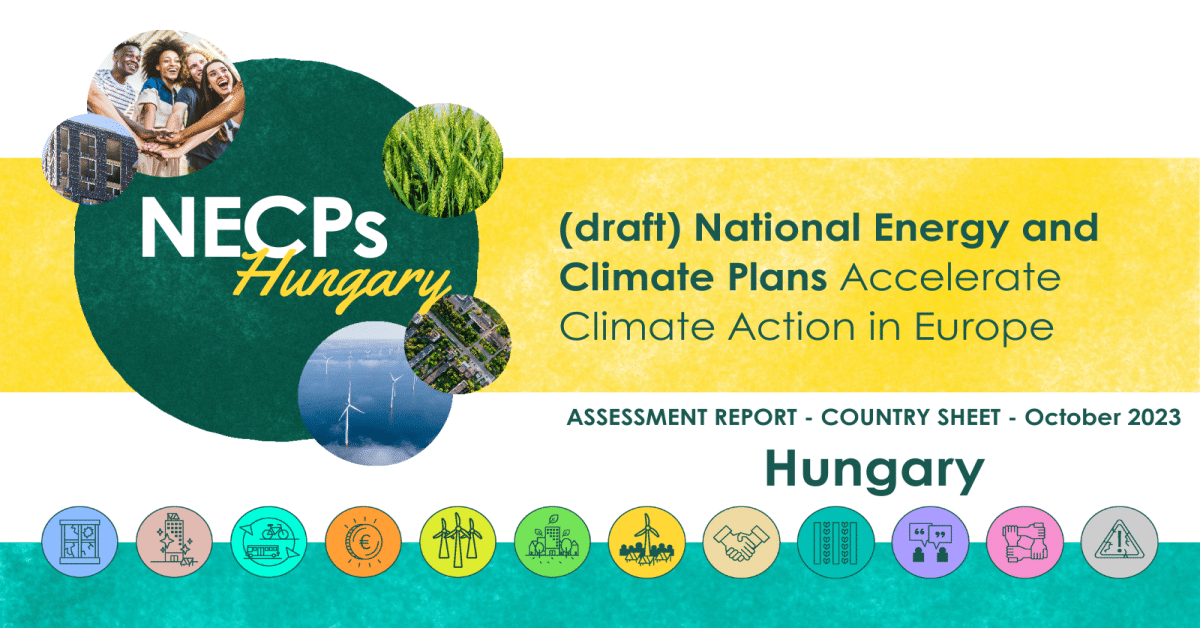The Hungarian draft National Energy and Climate Plan (NECP) update was submitted only in August 2023. This assessment is based on the version submitted to the Commission. Hungary overall does not move towards a 1.5°C trajectory. While the EU requirement for climate effort sharing is met, most decarbonisation efforts only occur after 2030. The contributions for renewable energy and energy efficiency are not even ambitious enough to align with the EU 2030 energy targets. Planned policies and measures (PAMs) are not enough to meet the national 2030 climate target. Coal phaseout is delayed and fossil gas infrastructure expanded.
RECOMMENDATIONS
- Plan for more deep renovations of buildings and support them with more funding than currently planned. EU and national Funds need to allow a yearly average of energy renovations of 130-140.000 homes, instead of the total 60.000 homes currently planned to be renovated till 2029 with EU Funds;
- Increase the renewables’ share in the energy mix. Wind capacity must increase to at least half of the PV capacity, energy communities must become more prominent, the electricity grid urgently upgraded;
- Remove all environmentally harmful subsidies and refrain from providing new ones, including subsidies for forced reindustrialisation, which could lead to +2 MtCO2-eq emissions annually, unsustainable energy demand levels and delayed fossil fuels phaseout.
-
Climate Ambition
The draft aims for a 2030 economy-wide climate target of -50% compared to 1990. This is not in line with a 1.5°C trajectory and with the 2050 climate neutrality target set in binding national legislation (Act XLIV of 2020) – which would require between 55%-60% emissions reduction by 2030.
Even with the additional PAMs planned in this draft, Hungary would fail to meet its -50% target: the WAM scenario expects emissions to fall by 47.2% by 2030 compared to 1990. The WAM scenario also shows that most decarbonisation efforts towards the 2050 climate neutrality goal only occur after 2030. For non-Emission Trading System (non-ETS) sectors, instead, the scenario with additional measures seems to be in line with the requirement set in the Effort Sharing Regulation (ESR) for Hungary – which is, however, unambitious (-18.7% compared to 2005 levels).
An assessment of PAMs raises doubts about the full credibility of the scenario with additional measures. Transport measures are not detailed and lack financial back-up; measures planned in the buildings sector only back up about 60.000 home renovations until 2030; in the industry sector, planned re-industrialisation policies could emit at least an extra 2Mt of emissions per year.
Energy Transition
Hungary sets a renewable energy contribution of 29% in 2030, which might not be in line with the Governance Regulation formula benchmark to reach the binding EU 2030 renewable energy share of 42.5%. It also does not provide a clear framework for renewables investments nor lifts the legal limits that slow down solar and, notably, wind energy generation. Energy communities are only marginally addressed. Even though the planned solid biomass used will not be as dominant as today, there is no PAM explaining how electricity production on the basis of biomass will be eliminated by 2030, which seems unrealistic in light of ongoing biomass projects.
For energy savings, the level of energy consumption foreseen for 2030 does not exceed 750 PJ for final energy consumption, which equals 17.91 Mtoe. This is not in line with the requirements of the 2023 Energy Efficiency Directive (EED) and with the 2030 EU energy efficiency target. The gap towards the required contribution as per formula in the 2023 directive amounts to 1.72 Mtoe for final energy; with a possible deviation of 2.5% the gap would still amount to 1.3 Mtoe. Hungary fails to indicate the level of primary energy consumption in 2030, though a projection with additional measures indicates 28.88 Mtoe. This would be too high, as primary energy consumption should surpass a minimum reduction of energy consumption of 23.31 Mtoe in 2030 as per formula of the EED. Hungary’s re-industrialization strategy with 50 mostly new, battery-related factories stands in contrast to the planned reduction of energy consumption. Energy efficiency policies and measures lack detail and the deep energy renovation of homes is not given enough priority and financial support. Energy poverty and related issues of affordability and access to energy are barely addressed in the updated national energy and climate plan.
FOSSIL FUELS ALERT
- Coal –Lignite-fired units of Mátra power plant would be phased out only after a new fossil gas power plant is switched on (and at the latest by 2030). This is a step back from the 2019 NECP and contradicts the coal phaseout commitment made in the Territorial Just Transition Plans.
- Fossil gas – 1500 MW new fossil gas capacities (3 new fossil gas-power units) are planned in the draft, but no coherent justification is provided. Building a fossil-based plant contradicts decarbonisation and importing fossil gas from outside of the EU), instead of importing electricity from the EU, is not an improvement for energy security.
FALSE SOLUTION ALERT
- Hungary does not clearly say how and which hydrogen infrastructure should be developed, and for what. The plan should support only renewables-based hydrogen, and only for energy intensive industries that are hard to decarbonize.
IS MONEY WHERE THE MOUTH IS?
- A considerable amount of REPowerEU and Recovery funds is planned to finance the increase in electricity demand from the industrial sector (as a consequence of the reindustrialization strategy) and the “diversification” of fossil fuel dependency. Only a scarce amount goes to measures that would truly accelerate the transition and most needed by the population, e.g. support for building renovation.
PUBLIC PARTICIPATION
- Public consultations have slightly improved compared to 2019, but more still needs to be done. Fundamental issues are already decided when they enter the public domain: even if a summary of the draft was provided for consultation, its key boundaries and cornerstones (e.g. the re-industrialisation strategy) were provided without alternatives.
Download hungary country sheet NECP assessment report
Download FULL NECP assessment report
PREVIOUS
NEXT

